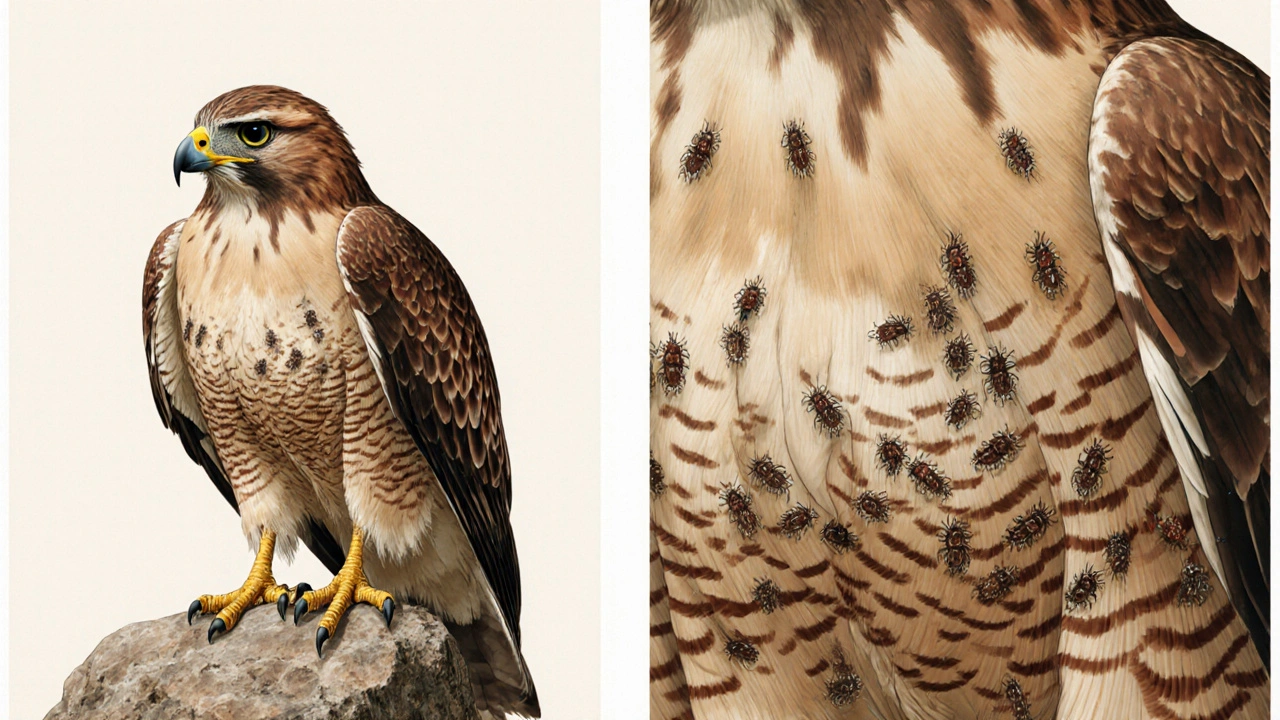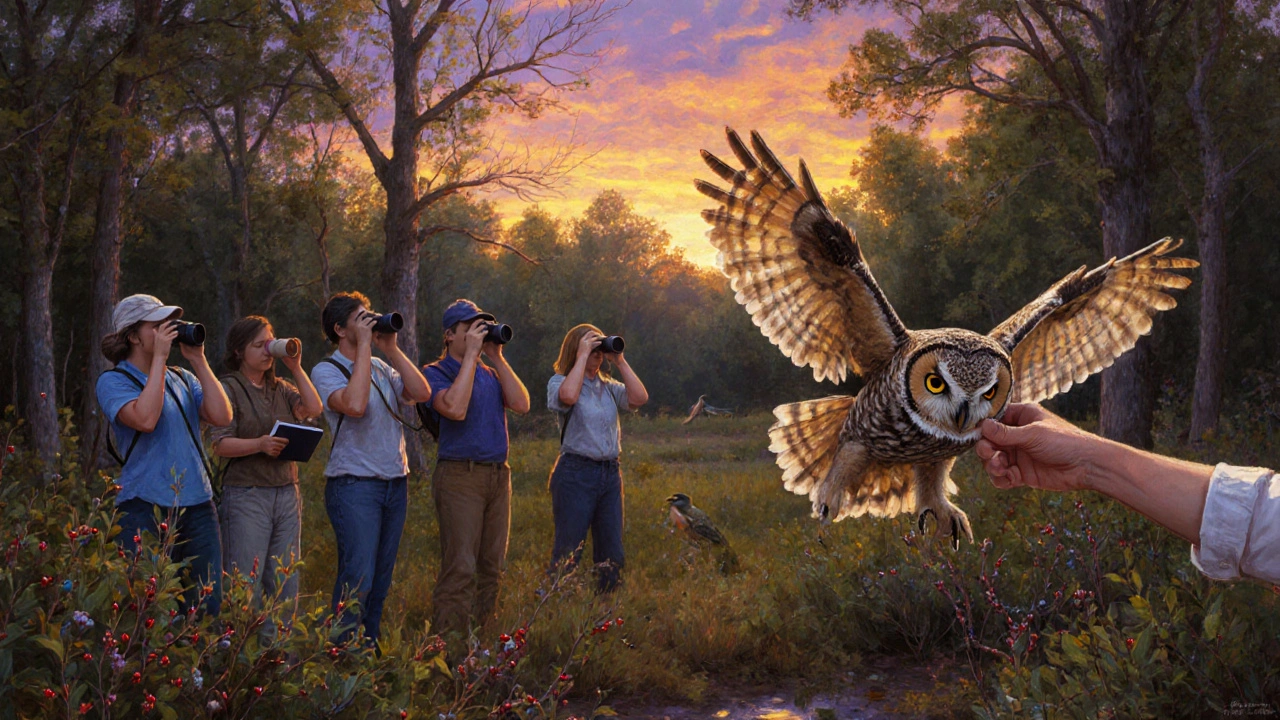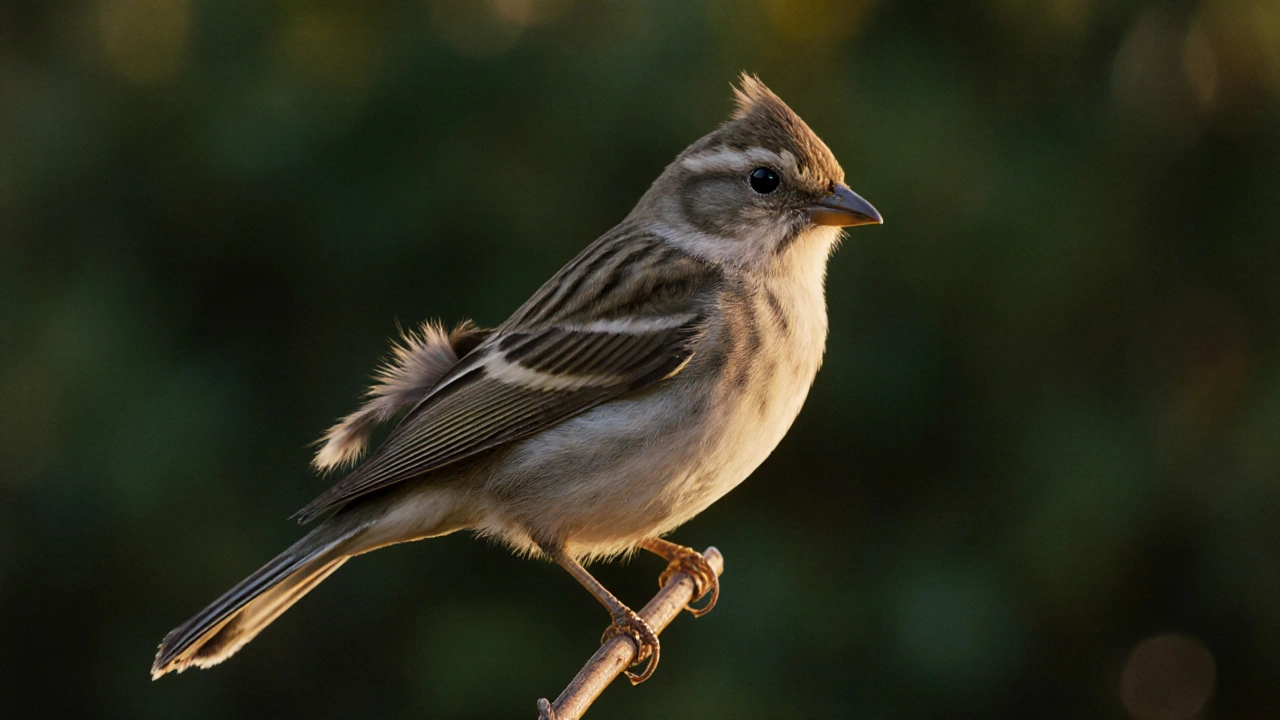Deplumation Symptom Checker
Deplumation Assessment Tool
This tool helps birdwatchers and conservationists assess the severity of deplumation in wild birds and identify potential causes based on observed symptoms.
Severity Assessment
Deplumation is a condition where wild birds lose or damage feathers outside the normal molting cycle. It looks like ragged patches, holes, or completely bare skin and can happen to any species, from sparrows to raptors. While a few feather losses are harmless, extensive deplumation often signals deeper health or environmental problems.
Key Takeaways
- Deplumation results from parasites, diseases, nutrition gaps, and habitat stress.
- Severe feather loss lowers survival by impairing flight, thermoregulation, and breeding success.
- Early detection through visual checks and feather sampling helps intervene before populations decline.
- Conservation actions focus on habitat restoration, parasite management, and targeted rehabilitation.
- Community monitoring programs empower birdwatchers to contribute valuable data.
What Triggers Deplumation?
Researchers have grouped the drivers into three broad categories: biological agents, environmental stressors, and physiological disturbances.
1. Parasite Infestation
Parasite infestation refers to mites, lice, and feather flies that feed on the skin or feather bases. The most common culprits are Knemidocoptes mites (causing scaly leg disease) and Philopteridae lice. Heavy loads gnaw at the feather shaft, creating bald spots that can expand quickly during breeding season.
2. Infectious Diseases
Avian pox and viral infections that produce lesions on the skin and feather tracts. Infected birds develop crusty, wart‑like growths that break down feather integrity. Another frequent cause is coccidiosis, a gut parasite that depletes nutrients needed for feather synthesis.
3. Nutrition and Molting Disruption
Feather production demands protein, amino acids (especially cysteine), and certain minerals. When nutritional deficiency occurs-often because of poor-quality food sources or seasonal scarcity-birds cannot replace old feathers properly. This leads to “broken‑wing” syndrome, where new feathers grow weak and break off.
4. Environmental Pressures
Rapid habitat degradation-from urban expansion to deforestation-reduces insect prey and safe roosting sites. Climate change adds another layer, intensifying heat stress and altering migration timing. Birds forced into marginal habitats expend more energy and often skip molting, making feathers prone to loss.
How Deplumation Affects Bird Survival
Feathers do more than look pretty; they are essential for flight stability, insulation, waterproofing, and courtship displays. When birds lose feathers, several cascading effects follow:
- Reduced flight efficiency: Bare patches increase drag and decrease lift, making it harder to escape predators or hunt.
- Thermoregulation problems: Feathers trap air; loss leads to rapid heat loss in cold climates and overheating in summer.
- Waterproofing breakdown: Wet feathers become heavy, risking drowning during rain or while foraging on water.
- Breeding setbacks: Many species use bright plumage to attract mates. Deplumed individuals are often ignored, cutting reproductive output.
- Higher disease susceptibility: Open skin invites secondary infections, compounding mortality risk.
Field studies in North America show that heavily deplumed Great Horned Owls have a 30% lower fledgling success rate compared to fully feathered pairs.

Monitoring and Diagnosing Deplumation
Effective conservation starts with solid data. Here’s a step‑by‑step workflow that citizen scientists and wildlife agencies can adopt:
- Perform a visual survey during peak activity hours (dawn/dusk). Note feather loss patterns, location on the body, and any visible lesions.
- Collect a small feather sample (if permitted) for microscopic examination to identify mite or lice presence.
- Record environmental variables-temperature, habitat type, recent land‑use changes-to correlate stressors.
- Upload observations to a centralized platform such as eBird, tagging them with the keyword “deplumation”.
- Analyze trends annually to spot hotspots where intervention is needed.
Technology aids the process: portable dermatoscopes and DNA barcoding kits can pinpoint pathogen species within minutes, allowing rapid response.
Conservation Efforts That Work
Across the globe, agencies are blending habitat restoration with targeted health interventions. Below are the most successful approaches:
- Habitat enrichment: Planting native berry shrubs and insect‑rich understory gives birds balanced nutrition, reducing deficiency‑driven deplumation.
- Parasite control programs: In high‑density colonies (e.g., seabird cliffs), periodic acaricide dusting has cut mite‑related feather loss by up to 45%.
- Rehabilitation and release: Specialized centers, such as the Wildlife Rehabilitation Centre in Nova Scotia, treat severe cases with feather grafts and nutritional supplements before returning birds to the wild.
- Policy advocacy: Protecting critical stopover sites along migration routes through legal designations (e.g., Important Bird Areas) curtails habitat loss.
- Community outreach: Training local birdwatchers to recognize early signs creates a rapid alert network.
Comparison of Major Causes
| Cause | Typical Agent | Primary Symptoms | Most Affected Species |
|---|---|---|---|
| Parasite Infestation | Mites (Knemidocoptes), lice (Philopteridae) | Scratching, bald patches, skin irritation | Songbirds, raptors near urban parks |
| Infectious Disease | Avian pox virus, coccidia | Lesions, crusts, systemic weakness | Waterfowl, ground‑nesting birds |
| Nutrition Deficiency | Low protein, inadequate amino acids | Weak, broken feathers; delayed molt | Hummingbirds, migratory passerines |
| Habitat Degradation | Urban sprawl, deforestation | Stress‑related feather loss, poor condition | Forest dwellers, cliff‑nesting species |
| Climate Extremes | Heat waves, unexpected cold snaps | Thermal stress, incomplete molt | High‑latitude migrants, coastal gulls |

Practical Checklist for Birdwatchers
- Carry a small notebook or a mobile app to log feather condition.
- Focus on the wing primaries, tail feathers, and head crown-these areas reveal most loss.
- When possible, photograph the bird from a distance to capture detail without disturbance.
- Note any visible parasites (tiny moving specks) or skin lesions.
- Report findings to local wildlife groups; include date, location, and weather.
Looking Ahead: Research Gaps and Opportunities
Although we know a lot about the obvious culprits, several questions remain:
- How does sub‑lethal pesticide exposure interact with parasite loads to exacerbate feather loss?
- Can probiotic treatments boost gut health enough to improve feather regeneration?
- What genetic markers predict susceptibility to severe deplumation in captive breeding programs?
Answering these will sharpen our toolbox and keep wild bird populations resilient.
Frequently Asked Questions
Why do some birds lose feathers while others don’t?
Feather loss depends on a mix of health status, parasite load, nutrition, and environmental stress. Species with strong immune systems or access to diverse food tend to resist severe deplumation.
Can I treat a wild bird with deplumation myself?
Direct treatment of wild birds is best left to licensed rehabilitators. However, you can help by improving habitat quality-plant native shrubs, limit pesticide use, and report sick birds to local authorities.
How quickly can feathers grow back after a loss?
If the bird is healthy and has adequate nutrition, new feathers can begin forming within a week and reach full length in 4‑6 weeks, depending on species and molt stage.
Is deplumation linked to climate change?
Yes. Climate‑induced heat stress and altered food webs increase physiological strain, often causing birds to skip or truncate molt, which shows up as feather loss.
What role do citizen scientists play in monitoring deplumation?
Volunteers provide large‑scale, real‑time data that professional researchers can’t collect alone. By tagging sightings with clear photos and notes, they help map hotspots and guide targeted interventions.

8 Comments
Your article's terminology is accurate, but watch the pluralization of “feather loss.”
India has a long tradition of revering birds, and we cannot ignore how habitat destruction here fuels deplumation across the subcontinent. The piece offers solid data, yet it glosses over the massive impact of agricultural expansion in the Indo‑Gangetic plains. When you talk about parasite control, remember that local farmers already use age‑old, effective methods that western researchers tend to overlook. The climate stress you mention is real, but the Indian monsoon's shifting patterns make it even more urgent to act locally. A coordinated citizen‑science network could turn this knowledge into action faster than any top‑down policy.
Deplumation is a sad sign that a bird is hurting.
When a bird loses feathers it cannot keep warm.
It also cannot fly well which makes it easy prey.
The article points out many reasons but we can add a few more thoughts.
Parasites are tiny and they chew at the feather base.
A heavy load of mites can turn a healthy sparrow into a bald creature.
Diseases like avian pox leave crusty sores that break feathers.
Not many people think about how a lack of protein can stop new feathers from growing.
If a bird eats mostly seeds without enough insects it will make weak feathers.
Climate change makes the problem worse because hotter days stress birds.
Heat makes birds pant and lose water faster, which can thin their plumage.
Drought also reduces insects, so birds get less protein.
Habitat loss adds another layer, as birds are forced into poorer areas.
In cities they may sit on windows and get hit, losing feathers from injury.
All these factors mix together and make a bad situation for the bird.
The good news is that people can help by planting native bushes that bring insects.
Simple steps like putting up bird boxes can give safe places to rest.
Finally, reporting sick birds to wildlife groups creates data that scientists need.
Interesting read,, especially the part about habitat stress,, and the data tables,, are very helpful.
The methodology section leverages a multivariate logistic regression framework to parse the covariate interactions, thereby enhancing the predictive fidelity of deplumation risk assessments without imposing additional interpretive burdens on field operatives.
From an epidemiological modelling perspective, the prevalence indices presented could be recalibrated using Bayesian hierarchical priors to better account for spatial autocorrelation inherent in avian population datasets.
Do the seasonal migration patterns influence the intensity of feather loss?
Great question! Seasonal migrants often experience heightened stress during long flights, which can exacerbate feather wear and make them more vulnerable to parasites. By mapping stopover habitats with rich insect diversity, we can offer them nutritional refueling stations that help maintain feather integrity. Community groups can set up “bird rest stops” with native plantings to support these travelers.
Write a comment